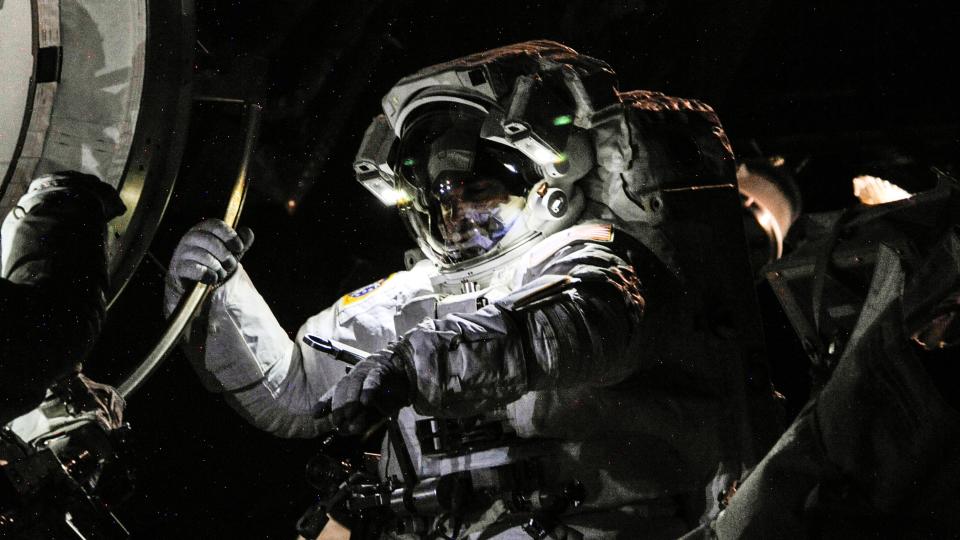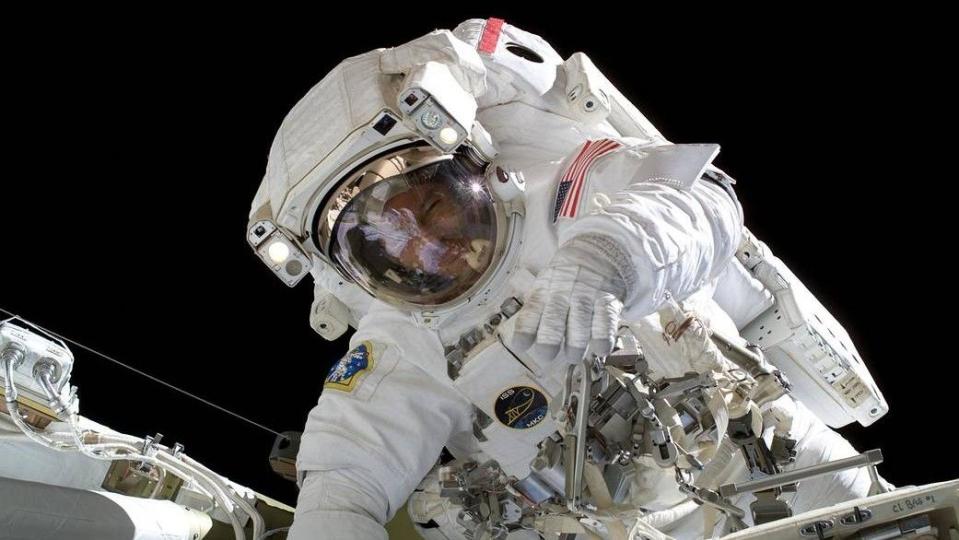When you buy through links in our articles, Future and its syndication partners may earn commission.

NASA said the next spacewalk will be postponed indefinitely until engineers better understand what caused the coolant leak on June 24.
NASA astronaut Tracy Dyson suffered a brief spacesuit leak while in the International Space Station (ISS) hatch a month ago. She and Mike Barrett had just opened the hatch for a 6.5-hour spacewalk for maintenance activities when a shower of ice particles burst from a spacesuit connection leading to the ISS. The spacewalk was suspended, but the astronauts were never in danger, NASA stressed.
“The spacewalk ended early due to a water leak in the suit’s service and cooling umbilical, which is where it connects to the ISS,” NASA station program manager Dana Weigel told reporters in a teleconference on Wednesday (July 17). (Astronaut spacesuits remain connected to the ISS life-support systems through this umbilical until just before they exit the hatch.)
“We’re still looking at the cause of the water leak and what we want to do to recover it,” Weigel added. “We’ll look for the next opportunity where we want to do a spacewalk. It’s not time-critical or urgent, so we’ll find the best and most logical place to put it.”
NASA’s extravehicular mobility unit (EMU) spacesuit used on spacewalks has a design dating back to the 1970s and was first used during the space shuttle mission STS-6 in April 1983. The EMU has a long and reliable flight legacy: It was the spacesuit used on all space shuttle spacewalks, facilitated crew maintenance of the Hubble Space Telescope, and also helped astronauts build the ISS.
The EMU has replaceable parts that can be replaced and maintained. However, it has been prone to periodic coolant leaks in recent years for various reasons. NASA suspended spacewalks for seven months in March 2022, for example, after water was discovered in a spacesuit helmet. And an incident in July 2013 prompted an investigation report and additional months of spacewalk suspension after Italian astronaut Luca Parmitano’s helmet filled with water during a spacewalk.
The next generation of spacesuits from NASA and the private sector emphasizes improved flexibility with updated materials, along with improved sizing to accommodate all genders. The EMU is larger and skews toward male sizes because it was designed at a time when most astronauts were male candidates from the then-virtually single-gender armed forces. Collins Aerospace pulled out of its contract to design the newer ISS suits in June, saying the development program “will not support the space station program and NASA’s mission objectives.”
Relating to: ISS astronauts conduct ‘spacewalk inspection’ after spacesuit coolant leak


The cause of the latest leak is not yet known, but Expedition 71 astronauts have spent hours troubleshooting in recent weeks and NASA is reviewing that information.
NASA had initially planned three spacewalks in June and July, but reduced them to two after the June 13 spacewalk was suspended due to “spacesuit discomfort.” The second in the revised series was initially expected on July 2, but as Weigel noted on July 17, overall spacewalk needs will be reviewed in the coming months.
Weigel noted at the same conference that spacewalks are among the “dynamic activities” hosted by the ISS. Such activities occur roughly every week or 10 days, he said, when “something like a visiting vehicle docking or undocking is included.” [or] space walk, [or] “Robotics.” (The ISS has a variety of robotic arms and devices that perform maintenance and science work, usually controlled from the ground.)
RELATED STORIES:
— NASA postpones next ISS spacewalk until end of July due to spacesuit leak issue
— A leak at the ISS canceled a spacewalk. But one astronaut says it was the right decision
— NASA says this month’s rare all-female spacewalk won’t be the last
Schedules in space are always in flux, but the last few weeks have been particularly uncertain in terms of ISS planning.
The Boeing Starliner spacecraft’s first astronaut test flight to the ISS was initially delayed from May 6 due to a helium leak that NASA and Boeing thoroughly analyzed and fixed before approving the launch. (Such development efforts often involve uncertainty because the spacecraft and systems are new to launching humans.)
After arriving at the ISS on June 6, the 10-day Crew Flight Test mission was eventually extended indefinitely due to thruster issues that delayed docking. Starliner remains rated for emergency separation from the ISS, but engineers are analyzing ground tests conducted last week to better analyze the performance of the Starliner system before it is authorized for six-month operational missions as early as 2025.
Some of NASA’s Expedition 71 crew arrived in March as part of SpaceX’s Crew-8 and launched into space on a SpaceX Falcon 9 rocket. Crew-9 was supposed to arrive in mid-August. While that schedule is still on NASA’s list, all Falcon 9 launches were suspended last week after an issue with the second stage of a Starlink satellite launch.
SpaceX has petitioned the Federal Aviation Administration to allow launches to resume, but NASA says it wants to conduct its own review before allowing SpaceX to launch astronauts or cargo to the ISS. (Different variants of the Falcon 9 are in use to carry astronauts and satellites.)